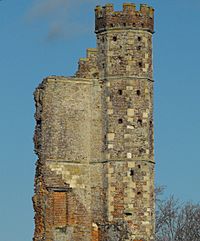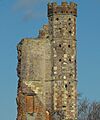Warblington Castle facts for kids
Quick facts for kids Warblington Castle |
|
|---|---|
| Hampshire, England | |

Part of the remains of Warblington Castle
|
|
| Coordinates | 50°50′40″N 0°57′57″W / 50.8444°N 0.9659°W |
| Type | Fortified manor house |
| Site information | |
| Condition | Ruined |
Warblington Castle was a large, fortified manor house located near Langstone in Hampshire, England. Most of the castle was destroyed during the English Civil War in the 1600s. Today, only a single gate tower, part of a wall, and a gateway remain. The land where the castle stood is privately owned, so visitors cannot go inside.
Contents
What is Warblington Castle?
Warblington Castle was a big house, built like a small fortress. It was surrounded by a moat, which is a deep, wide ditch usually filled with water, to protect it. The manor was built between 1515 and 1525. Sadly, much of it was ruined in 1644 during a big war in England.
Early History of the Site
The area where Warblington Castle stands has been settled for a very long time. A Saxon village was here as early as the 600s. This settlement was even mentioned in the Domesday Book of 1086. The Domesday Book was a huge survey ordered by William the Conqueror to record land and property in England. It showed that about 120 people lived there at that time.
The land changed hands many times over the centuries. One important owner in the 1400s was Richard Neville, 16th Earl of Warwick, also known as "the Kingmaker." He turned the land into a private deer park, which meant the villagers had to move away.
Royal Connections
After Richard Neville's relative, Edward Plantagenet, 17th Earl of Warwick, was executed by King Henry VII, the manor became property of the Crown. This means it belonged to the King.
In 1513, King Henry VIII gave the manor to Margaret Pole, Countess of Salisbury. She was the one who had the new, moated manor house built on the site. However, Margaret Pole was later accused of treason and lost her property.
Other important people stayed at Warblington Castle. In 1551, Mary of Guise, the queen of Scotland, visited and stayed a night. King Edward VI also visited in 1552. It's even thought that Queen Elizabeth I might have visited for two days in 1586!
The Cotton family owned the house for many years, right up until the English Civil War.
The English Civil War and Destruction
The English Civil War was a conflict between the King's supporters (called Royalists) and the Parliament's supporters (called Parliamentarians). The Cotton family who owned Warblington Castle were Royalists.
In January 1643, Parliamentarian soldiers, led by Colonel Norton, took over the house. They had about 40 to 80 men guarding it. But then, a Royalist leader named Lord Hopton attacked the castle. He managed to capture it, though Colonel Norton escaped.
Because the Cotton family supported the King, Parliamentarian forces largely destroyed Warblington Manor. They left only one turret of the gatehouse standing. This turret was kept as a landmark to help ships navigate in the nearby Langstone channel.
What Remains Today
The remaining turret is octagonal (eight-sided) and four stories tall. It's mostly built from brick with stone decorations and battlements (the top part of a castle wall with gaps for defense).
After the war, the property was given back to the Cotton family. They built a farmhouse nearby, which is now a historic building itself.
Today, you can still see the turret, the arch of the gate, and the supports for the old drawbridge in the moat. The land is still private property. The castle ruins are protected as a Grade II* listed building and a scheduled Monument. This means they are very important historical sites.
The Area Around the Castle
Warblington Castle is located within the Warblington Conservation Area. This special area also includes the Old Farm House, an old cemetery, the historic St Thomas à Becket Church, Warblington, and the Old Rectory.
As of 2020, the castle property was owned by retired Olympic rowers, Tom and Diana Bishop. They live in the Old Farm House on the property. The property also has large gardens, an orchard, and a swimming pool.
Images for kids



